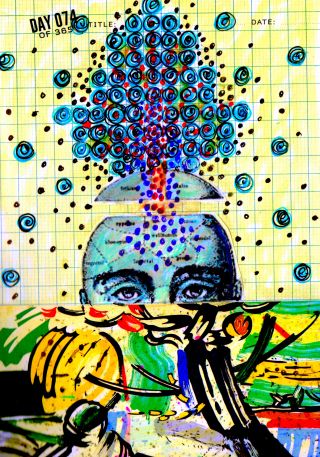Trauma
Bilateral Drawing: Self-Regulation for Trauma Reparation
Let’s draw on the power of both hands to modulate stress.
Posted September 29, 2015 Reviewed by Ekua Hagan
Key points
- Bilateral stimulation engages both hemispheres of the brain, connecting "thinking" to feeling," which has an impact on trauma recovery.
- Bilateral stimulation may help regulate body and mind, allowing trauma survivors' explicit memory to be reconnected with their implicit memory.
- Bilateral drawing, a form of art therapy, can be used by trauma survivors to ground themselves. This can reduce the freeze response.

In working with survivors of acute and repeated traumatic events over the last several decades, I am always particularly conscious of individuals’ self-regulating capacities initially and throughout our work together.
Self-regulation is currently a ubiquitous term used to describe not only the capacity to control one’s impulses, but also to be able to soothe and calm the body’s reactions to stress. It is the ability to modulate affective, sensory, and somatic responses that impact all functioning, including emotions and cognition. It also refers to the brain’s executive function to control impulses, delay actions if necessary, and initiate them if necessary, even if one does not want to.
By the simplest definition, bilateral simply means “involving two sides.” Sensory integration is often associated with bilateral techniques that assist individuals in organizing specific sensations via methods found in occupational therapy.
In the process of reparation from psychological trauma, various forms of bilateral stimulation or movement seem to be effective in engaging cross-hemisphere activity in the brain (Shapiro, 2001) and in art therapy possibly because it reconnects “thinking” and “feeling” (Malchiodi, 2003/2011) via the sensory-based processes involved in art-making. These applications seem to have an impact on recovery from traumatic events because, for many individuals, the limbic system and right hemisphere of the brain are hyperactivated by actual experiences or memories of trauma. In brief, specific processes found in bilateral stimulation may help regulate body and mind thus allowing explicit memory to be reconnected with implicit memory.
Bilateral drawing for trauma processing

Bilateral drawing is a deceptively simple art-based activity that has been around since at least the 1950s that capitalizes on self-regulating properties similar to rocking, walking, cycling, or drumming. Some art therapy practitioners refer to bilateral drawing as “scribbling with both hands” because the intent is not necessarily to make a specific image but to instead just engage both hands in spontaneous drawing with chalks, pastels, or other easily manipulated art materials.
Like many art and expressive arts therapists, I have used this activity for several decades and actually learned it during college art courses as a way of “loosening up” before beginning to draw or paint.
Florence Cane (1951) is one of many early art therapy practitioners who observed a connection between free-form gestural drawing on paper, the kinesthetic sense involved in the movement, and the embodied qualities of the experience. In her work with children and adults in the mid-20th century, Cane hypothesized that it is important to engage individuals through movements that go beyond the use of the hands to engage the whole body in natural rhythms. In particular, she refers to large swinging gestures that come from the shoulder, elbow, or wrist to not only liberate creative expression but also act in a restorative capacity to support healthy rhythms in the body and mind. In other words, these rhythmic movements can be practiced in the air and then later transferred to paper with drawing materials.
Therapists echo Cane’s observations in clinical applications of expressive art with individuals, using several variations of the simple scribble in cases of trauma and bilateral drawing methods (McNamee, 2003) for not only self-regulation but also in trauma processing (Malchiodi, in press; Urhausen, 2015). In the case of bilateral drawing, there is an assumption that because both hands are engaged that both hemispheres of the brain are stimulated. This concept reflects Shapiro’s model of Eye Movement Desensitization and Reprocessing (EMDR) (2001) treatment that involves dual-attention stimulation and consists of a practitioner facilitating bilateral eye movements, taps, and sounds as sensory cues with an individual. When combined with trauma narratives, it is believed that visual, auditory, or tactile cues help the individual by directing focus on the present rather than what has happened in the past. While applications of bilateral drawing methods and the integration of artistic expression within the practice of EMDR seem to be effective, most of these art-based applications have not been thoroughly explained through evidence-based research and only demonstrate preliminary effectiveness through small-scale observational studies and case examples.
Bilateral drawing as a method of self-regulation
I believe bilateral drawing, guided by a helping professional, is helpful simply as a method of self-regulation. In particular, it can be introduced as a grounding technique because it is a novel, non-threatening yet embodied experience for most individuals.
As an expressive arts intervention, bilateral work can also be an embodied process especially if the individual creates using bold gestures and large muscle groups; music can also enhance and shift the dynamics of the experience through various rhythms that stimulate and engage the person on a kinesthetic level.
In work with trauma reactions, I find that bilateral expressive work is useful with both individuals who are easily hyperactivated (fight or flight) or are susceptible to reacting to distress with a freeze response; these individuals often need experiences that involve movement in order to reduce their sensations of feeling trapped, withdrawn, or dissociated. Making marks or gestures on paper with both hands simultaneously also creates an attention shift away from the distressing sensations in the body to a different, action-oriented, and self-empowered focus. It capitalizes on the embodied, self-soothing experiences originally observed by Cane almost seven decades ago and takes advantage of the power of “drawing on both sides” to alter one’s own internal rhythms for self-regulation and well-being.
Be well and draw on both sides of your brain,
Cathy Malchiodi, PhD
References
Cane, F. (1951). The artist in each of us. London: Thames and Hudson.
Malchiodi, C. (2003/2011). Art therapy and the brain. In C. Malchiodi (Ed.), Handbook of Art Therapy (pp. 17-26). New York: Guilford.
McNamee, C. 2003 Bilateral art: Facilitating systemic integration and balance. The Arts in Psychotherapy, 30(5): 283-292. DOI: 10.1016/j.aip.2003.08.005
Shapiro, F. (2001). Eye movement desensitization and reprocessing (EMDR). New York: Guilford.
Urhausen, M. T. (2015). Eye movement desensitization and reprocessing (EMDR) and art therapy with traumatized children. In C. Malchiodi (Ed.), Creative Interventions with Traumatized Children (pp. 45-74). New York: Guilford.


